|
|
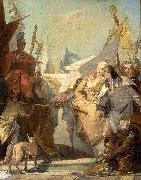 |
Francesco Zugno
|
|
Francesco Zugno (c. 1708-1787) was an Italian painter of the Rococo period. He was born in Brescia. Among his masterworks is a series of wall frescoes of figures in quadratura balconiesepart genre, part courtly conceit. He was strongly influenced by Giovanni Battista Tiepolo and his works. |
|
|
|
 |
FRANCIA, Francesco
|
|
Italian High Renaissance Painter, 1450-1517
He turned to painting c. 1485, and his first works already testify to the considerable technical accomplishment and gentle religious sensibility that remained constants of his art. His major surviving paintings are altarpieces, mostly images of the Virgin and saints, initially done for Bologna and later for nearby centres, notably Parma, Modena, Ferrara and Lucca. He also painted many small-scale devotional works and a few portraits. The apochryphal anecdote reported by Vasari that Francia died on seeing Raphael's altarpiece of St Cecilia |
|
 |
FRANCIABIGIO
|
|
Italian High Renaissance Painter, 1484-1525
Italian painter. The son of a Milanese linen-weaver, he had completed his apprenticeship, in Florence, by 18 October 1504. His earliest documented works, for example a Piete (1506) for S Pancrazio, Florence, have not survived. According to Vasari, Franciabigio trained with Mariotto Albertinelli, in whose last work, the signed and dated Crucifixion (1506; Florence, Certosa del Galluzzo, Pin.), he painted the angels (Shearman). In December 1508 the names of Franciabigio and Andrea del Sarto, who sometime between autumn 1506 and 1509 set up a joint workshop, were entered in the registration book of the Arte de' Medici e Speziali, to which painters were required to belong. The Portrait of a Young Man (Paris, Louvre) dates from this period. The work, which was later enlarged, shows the subject half-length, leaning pensively against a balustrade, with strong areas of shadow around the eyes. This is the first in a series of male portraits typical of Franciabigio: the subjects, each of whom wears a hat, are mostly placed in front of a landscape, with their gaze fixed meditatively or piercingly on the onlooker. The religious works from this period, such as the Virgin and Child (1509; Rome, Pal. Barberini), also show a movement away from the style of Albertinelli and Raffaellino del Garbo and begin to reveal instead the influence of Leonardo, Michelangelo and, especially, Raphael. Yet Franciabigio's connection with Andrea del Sarto was the determining factor in his career. When in 1509 it was del Sarto who received the commission to complete the fresco cycle in the atrium of SS Annunziata, Florence, their relationship altered significantly. |
|
|
|
|
|
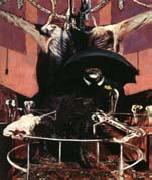 |
Francis Bacon
|
|
English , 1561-1626
British statesman and philosopher, father of modern scientific method. He studied at Cambridge and at Gray's Inn. A supporter of the Earl of Essex, Bacon turned against him when Essex was tried for treason. Under James I he rose steadily, becoming successively solicitor general (1607), attorney general (1613), and lord chancellor (1618). Convicted of accepting bribes from those being tried in his court, he was briefly imprisoned and permanently lost his public offices; he died deeply in debt. He attempted to put natural science on a firm empirical foundation in the Novum Organum (1620), which sets forth his scientific method. His elaborate classification of the sciences inspired the 18th-century French Encyclopedists, and his empiricism inspired 19th-century British philosophers of science. His other works include The Advancement of Learning (1605), |
|
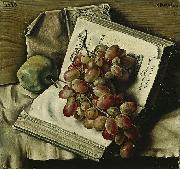 |
Francis Barraud
|
|
(14 November 1899 - 11 September 1934) was a Swiss painter.
Barraud was the eldest of four brothers who all painted or sculpted at various points in their lives.The brothers, François, Aim, Aurle and Charles, were largely self-taught artists having been raised as professional plasterers and house painters. Barraud attended evening classes at the local art school in 1911 together with his brothers. In 1919, he exhibited his paintings in La Chaux-de-Fonds and participated in the National Exhibition of Fine Arts in Basel.Encouraged by the success of the exhibitions he left Switzerland in 1922, and moved to Reims in France where he worked as a house painter for two years. He married Marie, a French woman, in 1924. Marie subsequently featured as a model in several of his paintings.Around 1924 or 1925, Barraud found work in Paris as an artist and craftsman. While living in Paris he studied painting at the Louvre.
François Barraud painted mainly still lifes, female nudes and portraits, including several double portraits of himself and his wife, Marie His precise, realist style of painting developed under the influence of the old Flemish and French masters he had studied at the Louvre.
Barraud suffered periods of illness throughout his life and died of tuberculosis in Geneva, in 1934, at the age of 34. |
|
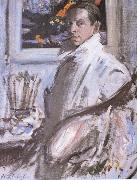 |
Francis Campbell Boileau Cadell
|
|
Scottish, 1883-1937, was a Scottish painter associated with the Scottish Colourists. Francis Cadell was born in Edinburgh and, from the age of 16, studied in Paris at the Academie Julian, where he was in contact with the French avant-garde of the day. While in France, his exposure to work by the early Fauvists, and in particular Matisse, proved to be his most lasting influence. After his return to Scotland, he was a regular exhibitor in Edinburgh and Glasgow, as well as in London. He painted landscapes, interiors, still life and figures in both oil and watercolour, but he is particularly noted for his portraits, depicting his subject with vibrant waves of colour. He enjoyed the landscape of Iona enormously, which he first visited in 1912 and features prominently in his work. |
|
|
|
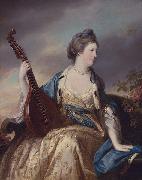 |
Francis Cotes
|
|
(20 May 1726 - 16 July 1770) was an English painter, one of the pioneers of English pastel painting, and a founder member of the Royal Academy in 1768.
He was born in London, the eldest son of Robert Cotes, an apothecary (Francis's younger brother Samuel Cotes (1734 - 1818) also became an artist, specialising in miniatures). Cotes trained with portrait painter George Knapton (1698 - 1778) before setting up his own business in his father's business premises in London's Cork Streetelearning, incidentally, much about chemistry to inform his making of pastels.
An admirer of the pastel drawings of Rosalba Carriera, Cotes concentrated on works in pastel and crayon (some of which became well-known as engravings). After pushing crayon to its limit as a mediumealthough he was never to abandon it entirelye - otes turned to oil painting as a means of developing his style in larger-scale works. In his most successful paintings, particularly those of the early 1760s, the oil paint is thinly applied, in imitation of his pastel technique, and imbued with charm, inviting comparisons with Allan Ramsay (1713 - 1784) and Sir Joshua Reynolds. They have clarity and warmth and possess a remarkable attention to costume. In 1763, he bought a large house (later occupied by George Romney) in Cavendish Square.
One of the most fashionable portrait painters of his day, Cotes helped found the Society of Artists and became its director in 1765. At the peak of his powers, Cotes was invited to become one of the first members of the Royal Academy, but died just two years later, aged 44, in Richmond.
He also taught pastel skills to John Russell, and his skills were described in book The Elements of Painting with Crayon.
|
|
 |
Francis Danby
|
|
Irish Painter, 1793-1861
was a British painter of the Romantic eraBorn in the south of Ireland, he was one of a set of twins; his father, James Danby, farmed a small property he owned near Wexford, but his death, in 1807, caused the family to move to Dublin, while Francis was still a schoolboy. He began to practice drawing at the Royal Dublin Society's schools; and under an erratic young artist named James Arthur O'Connor he began painting landscapes. Danby also made acquaintance with George Petrie, and all three left for London together in 1824. This expedition, undertaken with very inadequate funds, quickly came to an end, and they had to get home again by walking. At Bristol they made a pause, and Danby, finding he could get trifling sums for water-color drawings, remained there working diligently and sending to the London exhibitions pictures of importance. There his large oil paintings quickly attracted attention. Danby painted "vast illusionist canvases" comparable to those of John Martin of "grand, gloomy and fantastic subjects which chimed exactly with the Byronic taste of the 1820s."The Upas Tree (1820) and The Delivery of the Israelites (1825) brought him his election as an Associate Member of the Royal Academy. He left Bristol for London, and in 1828 exhibited his Opening of the Sixth Seal at the British Institution, receiving from that body a prize of 200 guineas; and this picture was followed by two others on the theme of the Apocalypse. In 1829 Danby's wife deserted him, running off with the painter Paul Falconer Poole Danby left London, declaring that he would never live there again, and that the Academy, instead of aiding him, had, somehow or other, used him badly. For a decade he lived on the Lake of Geneva in Switzerland, becoming a Bohemian with boat-building fancies, painting only now and then. He later moved to Paris for a short period of time. He returned to England in 1840, when his sons, James and Thomas, both artists, were growing up. Danby exhibited his large (15 feet wide) and powerful The Deluge that year; the success of that painting, "the largest and most dramatic of all his Martinesque visions, revitalized his reputation and career. Other pictures by him were The Golden Age (c. 1827, exhibited 1831), Rich and Rare Were the Gems She Wore (1837), and The Evening Gun (1848). Some of Danby's later paintings, like The Woodnymph's Hymn to the Rising Sun (1845), tended toward a calmer, more restrained, more cheerful manner than those in his earlier style; but he returned to his early mode for The Shipwreck (1859). |
|
 |
Francis Davis Millet
|
|
(November 3, 1846 - April 15, 1912) was an American painter, sculptor, and writer who died in the sinking of the RMS Titanic on April 15, 1912.
Francis Davis Millet was born in Mattapoisett, Massachusetts. At age sixteen, Millet entered the Massachusetts regiment, first as a drummer boy and then a surgical assistant in the American Civil War. He repeatedly pointed to his experience working for his father as giving him an appreciation for the vivid blood red that he repeatedly used in his early paintings. |
|
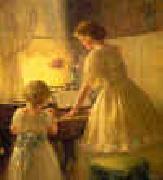 |
Francis Day
|
|
Francis Day CIE (1829-1889) was Inspector-General of Fisheries in India(from circa 1871) and Burma and an ichthyologist.
He was born on the 2nd of March 1829 Maresfield, Sussex, UK third son of William and Ann Day. He became the medical officer in the Madras Presidency, East India Company services in 1852.
Francis Day was created a Companion of the Order of the Indian Empire in 1885. He was decorated with the 0rder of the crown of Italy. He retired in 1877.
He wrote a monograph on fishes between 1875-1878 "The Fishes of India" with a supplement in 1888 and two volumes on "Fishes" in the Fauna of British India series in which he described over 1400 species. Also wrote British and Irish Salmonadae, which he illustrated with 9 plates, the colouring of which was done by Miss Florence Woolward. Francis Day was granted an honary LLD by the University of Edinburgh.
Also Published Fishes of Malabar in 1865
Franics Day was an active member, and president of the Cheltenham Natural Sciences Society and presented papers to them. Also was an active member of the Cotswold Field Club, where he was vice president. He died at his residence, Kenilworth House, Cheltenham on the 10th of July 1889 of cancer of the stomach. Buried in Cheltenham cemetery. |
|
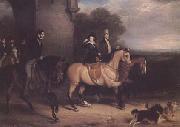 |
Francis Grant
|
|
Scottish Painter, 1803-1878
Scottish portrait painter. He was self-taught in painting, for which he abandoned a career in law. He began as a painter of hunting scenes (The Melton Hunt and The Cottesmore Hunt) but gained success as a fashionable portrait painter. Among his sitters were Scott, Macaulay, Disraeli, Palmerston, and Landseer. Sir Francis was president (1866 C 78) of the Royal Academy. |
|
|
|
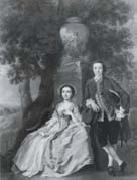 |
Francis Hayman
|
|
English Painter, 1708-1776,English painter and illustrator. He was in London at the age of 10, and from 1718 until c. 1725 he was apprenticed to Robert Brown (d 1753), a decorative painter. From 1732 Hayman was employed as a scene painter at Goodman's Fields Theatre, where he painted allegorical works such as The King Attended by Peace, with Liberty and Justice Trampling on Tyranny and Oppression on the pit ceiling (destr.). He moved to Drury Lane Theatre in 1736, shortly before the Licensing Act closed Goodman's Fields. At Drury Lane he painted scenery for Thomas Arne's masque The Fall of Phaeton (1736) and was praised for his naturalistic landscapes. From the late 1730s he began accepting commissions for portraits and conversation pieces. His success in the field of portraiture rested on the dearth of good portrait painters in England at the time and his exploitation of a growing middle-class clientele. Hayman painted portraits of doctors, literary men and actors. |
|
 |
Francis Holman
|
|
(1729-1784) was a British maritime painter, little recognised during his own lifetime, but whose paintings are now sought aftereHe is also notable as the teacher of Thomas Luny.
He was born in Ramsgate and baptized on 14 November 1729 at St Laurence-in-Thanet, Ramsgate.[1] He was the eldest son and second of six children of Francis Holman (1696-1739), and his wife, Anne Long (1707-1757). His father was a master mariner, and his grandfather a Ramsgate cooper. His younger brother, Captain John Holman (1733-1816), maintained the family shipping business and remained close to Francis throughout his life. Young Francis would certainly have been immersed in the maritime world during his up-bringing; the legacy of this early knowledge is a wealth of detail and accuracy in his later work.
The moonlight Battle of Cape St Vincent, 16 January 1780 by Francis Holman, painted 1780
A sixth-rate British man of war off Dover, by Francis Holman, 1777
A small shipyard on the Thames, by Francis Holman, between 1760 and 1784Francis Holman lived in at least five addresses in Wapping on the Thames in London. He married, firstly, Elizabeth, and they produced 3 sons; John (b. 1757), and two more sons, both named Francis, who died in infancy. Elizabeth's death is unrecorded, but on 7 May 1781 he married, secondly, Jane Maxted (c.1736-1790). He was apparently childless when he wrote his will in 1783.
|
|
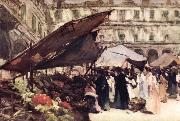 |
Francis Hopkinson Smith
|
|
Engineer, artist, illustrator, and short story writer
American , 1838-1915
United States author, artist and engineer, was born in Baltimore, Maryland, a descendant of Francis Hopkinson, one of the signers of the Declaration of Independence. Smith became a contractor in New York City and did much work for the federal government, including the stone ice-breaker at Bridgeport, Connecticut, the jetties at the mouth of the Connecticut River, the foundation for the Bartholdi Statue of Liberty in New York Harbor, the Race Rock Lighthouse (southwest of Fishers Island, New York) and many life-saving stations. His vacations were spent sketching in the White Mountains, in Cuba and in Mexico. |
|
|
|
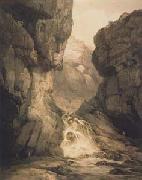 |
Francis Nicholson
|
|
English Painter, 1753-1844
English painter. After studying with a local artist in Scarborough, Nicholson began his career in his native Pickering, producing sporting pictures and portraits for Yorkshire patrons. In the mid-1780s a sideline in portraits of country houses led him to concentrate on landscapes in watercolour. From 1789 he contributed views of Yorkshire and Scotland to exhibitions at the Royal Academy. He also supplied topographical views for the Copper Plate Magazine. Although his market increasingly became London-based, Nicholson continued to live in Yorkshire (at Whitby, Knaresborough and Ripon), only moving to London c. 1803. |
|
|
|
|
|
 |
Francis Picabia
|
|
French Dadaist/Surrealist Painter
1879-1953
was a well-known painter and poet born of a French mother and a Spanish-Cuban father who was an attach?? at the Cuban legation in Paris, France. Born in Paris and financially independent, he studied under Fernand Cormon and other at the Ecole des Arts Decoratifs in the late 1890s. In the beginning of his own career, from 1903 to 1908, he was influenced by the impressionist paintings of Alfred Sisley. From 1909, he came under the influence of the cubists and the Golden Section (Section d'Or). The same year, he married Gabrielle Buffe. Around 1911 he joined the Puteaux Group, which met at the studio of Jacques Villon in the village of Puteaux. There he became friends with artist Marcel Duchamp and close friends with Guillaume Apollinaire. Other group members included Albert Gleizes, Roger de La Fresnaye, Fernand Leger and Jean Metzinger. In 1913 Picabia was the only member of the Cubist group to personally attend the Armory Show, and Alfred Stieglitz gave him a solo exhibition at his gallery 291. From 1913 to 1915 Picabia traveled to New York City several times and took active part in the avant-garde movements, introducing modern art to America. These years can be characterized as Picabia's proto-Dada period, consisting mainly of his portraits mecaniques. Later, in 1916, while in Barcelona he started his well-known Dada periodical 391, modeled on Stieglitz's own periodical. He continued the periodical with the help of Duchamp in America. Picabia continued his involvement in the Dada movement through 1919 in Zurich and Paris, before breaking away from it after developing an interest in Surrealist art. (See Cannibale, 1921.) He denounced Dada in 1921, and issued a personal attack against Breton in the final issue of 391, in 1924. The same year, he put in an appearance in the Rene Clair surrealist film Entr'acte, firing a cannon from a rooftop. |
|
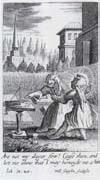 |
Francis Quarles
|
|
1592-1644,was born at Romford, London Borough of Havering, and baptized there on May 8 1592. Francis traced his ancestry to a family settled in England before the Norman Conquest with a long history in royal service. His great-grandfather, George Quarles, was Auditor to Henry VIII, and his father, James Quarles, held several places under Elizabeth I and James I, for which he was rewarded with an estate called Stewards in Romford. His mother, Joan Dalton, was the daughter and heiress of Eldred Dalton of Mores Place, Hadham. There were eight children in the family; the eldest, Sir Robert Quarles, was knighted by James I in 1608. Francis was entered at Christ's College, Cambridge, in 1608, and subsequently at Lincoln's Inn. He was made cupbearer to the Princess Elizabeth, in 1613, remaining abroad for some years; and before 1629 he was appointed secretary to Ussher, the primate of Ireland. About 1633 he returned to England, and spent the next two years in the preparation of his Emblems. In 1639 he was made city chronologer, a post in which Ben Jonson and Thomas Middleton had preceded him. At the outbreak of the Civil War he took the Royalist side, drawing up three pamphlets in 1644 in support of the king's cause. It is said that his house was searched and his papers destroyed by the Parliamentarians in consequence of these publications. Quarles married in 1618 Ursula Woodgate, by whom he had eighteen children. His son, John Quarles (1624-1665), was exiled to Flanders for his Royalist sympathies and was the author of Fons Lachrymarum (1648) and other poems. The work by which Quarles is best known, the Emblems, was originally published in 1635, with grotesque illustrations engraved by William Marshall and others. The forty-five prints in the last three books are borrowed from the Pia Desideria (Antwerp, 1624) of Herman Hugo. Each "emblem" consists of a paraphrase from a passage of Scripture, expressed in ornate and metaphorical language, followed by passages from the Christian Fathers, and concluding with an epigram of four lines. The Emblems was immensely popular with the common people, but the critics of the 17th and 18th centuries had no mercy on Quarles. Sir John Suckling in his Sessions of the Poets disrespectfully alluded to him as he "that makes God speak so big in's poetry." Pope in the Dunciad spoke of the Emblems, "Where the pictures for the page atone And Quarles is saved by beauties not his own." |
|
|
|
|
|
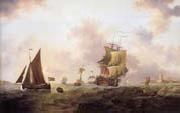 |
Francis Swaine
|
|
1720-1783,English painter and draughtsman. He worked as a messenger for a department of His Majesty's Navy in 1735 and seems to have been practising as a marine painter by the late 1740s, but there is little trace of his place in London's art world until his regular contributions from 1761 to the exhibitions of both the Free and Incorporated Societies of Artists. He was awarded the Society for the Encouragement of Arts' second prize for sea-pieces in 1764 and again in 1765. 'About the year 1770', reported Edwards, 'he painted the face of a wind-dial, with sea and ships, which he executed with a great neatness' |
|
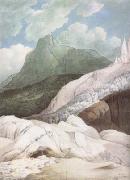 |
Francis Towne
|
|
English Painter, 1739-1816
was an English water-colour painter. He was born in Isleworth, Middlesex, the son of a corn chandler. Apprenticed to a coach painter in London, he won a design prize from the Society of Arts, and studied for a while at St Martin??s Lane Academy. In 1763 he was employed by a coach painter called Thomas Watson, and went to Exeter on business. He had already begun painting in oils and also taught drawing, and now he began to accept commissions from wealthy families in Devon. After a tour of north Wales in 1777, undertaken with his friend, the lawyer John White, he began to specialize in water-colours. In 1780 he travelled to Rome and from there to Naples. On his return to Devon, he was asked by Sir Thomas and Lady Acland of Killerton to paint some views in Devon and North Wales, and in 1786 he went on a painting tour of the Lake District |
|
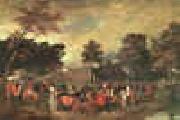 |
Francis Wheatley
|
|
1747-1801
British Francis Wheatley Location
Francis Wheatley (1747 - June 28, 1801), was an English portrait and landscape painter, was born at Wild Court, Covent Garden, London. He studied at Shipleys drawing-school and the Royal Academy, and won several prizes from the Society of Arts. He assisted in the decoration of Vauxhall, and aided Mortimer in painting a ceiling for Lord Melbourne at Brocket Hall (Hertfordshire). In youth his life was irregular and dissipated. He eloped to Ireland with the wife of Gresse, a brother artist, and established himself in Dublin as a portrait-painter, executing, among other works, an interior of the Irish House of Commons. His scene from the Gordon Riots of 1780 was engraved by Heath. He painted several subjects for Boydells Shakespeare Gallery, designed illustrations to Bells edition of the poets, and practised to some small extent as an etcher and mezzotint-engraver. It is, however, as a painter, in both oil and water-color, of landscapes and rustic subjects that Wheatley is best remembered. He was elected an associate of the Royal Academy in 1790, and an academician in the following year. His wife, as Mrs Pope after his death, was known as a painter of flowers and portraits. |
|
 |
Francis William Edmonds
|
|
American, 1806-1863,American painter and banker. He achieved recognition both as a painter and as a banker, juggling careers with consummate skill. In 1826 he enrolled at the National Academy of Design while working in a New York bank. Somewhat insecure, he initially exhibited between 1836 and 1838 under the pseudonym E. F. Williams, but favourable reviews subsequently prompted him to use his own name. In 1840-41 Edmonds spent eight months in Europe, where he studied the Old Masters; he particularly admired the 17th-century Dutch painters Pieter de Hooch and Gabriel Metsu. |
|
|
|
 |
Francisco Barrera
|
|
Spanish, 1595-1657,Spanish painter. Although he is sometimes thought to have been a Sevillian painter, his career is documented in Madrid. Barrera enjoyed considerable prestige and authority within the artistic community of the Spanish capital and in 1634 and 1639 represented his profession in significant legal battles concerning the status and rights of painters. However, Barrera's known paintings, all of which are still-lifes, are those of a derivative artist of modest abilities. In Still-life with Basket of Grapes, signed and dated 1642 (Florence, Uffizi), his arrangement of objects in a window-frame and on a stone ledge derives from works by Juan van der Hamen y Le?n but without that artist's refined compositional sense or mastery of pictorial space. The rather weak modelling of objects in this painting is consistent with Barrera's other still-lifes, which are further characterized by their light tonality, bland colouring and monotonous brushwork. Comparable stylistic features are found in the more accomplished still-lifes of Antonio Ponce, with whom Barrera is documented in the 1630s. Barrera's best works are those depicting the Four Seasons, signed and dated 1638 (Seville, priv. col., see 1982 exh. cat., pp. 78-85). These are still-lifes of abundant seasonal foodstuffs and, in landscape settings, large symbolic and genre figures drawn from traditional iconography. |
|
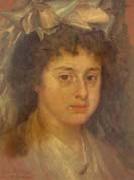 |
Francisco Bayeu
|
|
Spanish painter ,
1734, Zaragoza, Spain - 1795, Madrid
was a Spanish painter, active in a Neoclassic style, whose main subjects were religious and historical themes. Born in Zaragoza, he received a broad childhood education. His initial art studies were with a local master, Jos?? Luz??n[1] and Antonio Gonz??lez Vel??zquez. He then moved to Madrid, winning a scholarship with the painting of the ????Tyranny of Gerion???? to study in the Academia Real de Bellas Artes de San Fernando. The death of his parents and the care of his brothers forced him to return to Zaragoza, until he was recalled by Anton Raphael Mengs to help decorate the Royal Palace of Madrid. In later years, one of his colleagues was Francisco Goya, who married his sister, Josefa Bayeu. He served as court painter to King Charles III of Spain. He was named a professor of the Royal Academy of Fine Arts of San Fernando in 1765 and director in 1788. He painted in the Charterhouse of Aula Dei in Zaragoza. In 1767 he was named court painter for Charles III, king of Spain. He was involved in the decoration of various Royal palaces near Madrid. |
|
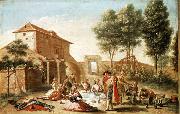 |
Francisco Bayeu y Subias
|
|
Spanish Painter, 1734-1795,was a Spanish painter, active in a Neoclassic style, whose main subjects were religious and historical themes. Born in Zaragoza, he received a broad childhood education. His initial art studies were with a local master, Jose Luzan[1] and Antonio Gonzalez Velazquez. He then moved to Madrid, winning a scholarship with the painting of the ????Tyranny of Gerion???? to study in the Academia Real de Bellas Artes de San Fernando. The death of his parents and the care of his brothers forced him to return to Zaragoza, until he was recalled by Anton Raphael Mengs to help decorate the Royal Palace of Madrid. In later years, one of his colleagues was Francisco Goya, who married his sister, Josefa Bayeu. He served as court painter to King Charles III of Spain. He was named a professor of the Royal Academy of Fine Arts of San Fernando in 1765 and director in 1788. He painted in the Charterhouse of Aula Dei in Zaragoza. In 1767 he was named court painter for Charles III, king of Spain. He was involved in the decoration of various Royal palaces near Madrid. |
|
 |
Francisco Camilo
|
|
Spanish painter (b. 1615, Madrid, d. 1673, Madrid)
was an Italian painter of the Renaissance period. He was born at Bassano del Grappa near Venice, the eldest son of Jacopo Bassano and grandson of Francesco da Ponte the Elder. He studied with his father and worked in the Bassano family workshop along with his three brothers, including Giambattista and Girolamo. He moved to Venice where he ran the branch of the family business, and where he was employed to paint a series of historical pictures in the Doge's Palace, but prone to hypochondria and other ailments, committed suicide by throwing self-defenestration soon after his father's death in 1592. |
|
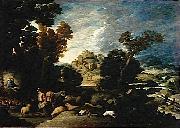 |
Francisco Collantes
|
|
(1599-1656) was a Spanish Baroque era painter.
Collantes was born in Madrid but sought influence from Jusepe de Ribera and the Neapolitan School. He was also influenced by 16th century Venetian painters and was renowned for his landscapes and biblical scenes. |
|
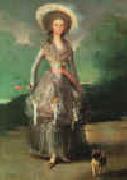 |
Francisco de Goya
|
|
Spanish
1746-1828
Francisco de Goya Locations
was an Aragonese Spanish painter and printmaker. Goya was a court painter to the Spanish Crown and a chronicler of history. He has been regarded both as the last of the Old Masters and as the first of the moderns. The subversive and subjective element in his art, as well as his bold handling of paint, provided a model for the work of later generations of artists, notably Manet and Picasso.
Goya married Bayeu's sister Josefa in July 25, 1773. His marriage to Josefa (he nicknamed her "Pepa"), and Francisco Bayeu's membership of the Royal Academy of Fine Art (from the year 1765) helped him to procure work with the Royal Tapestry Workshop. There, over the course of five years, he designed some 42 patterns, many of which were used to decorate (and insulate) the bare stone walls of El Escorial and the Palacio Real de El Pardo, the newly built residences of the Spanish monarchs. This brought his artistic talents to the attention of the Spanish monarchs who later would give him access to the royal court. He also painted a canvas for the altar of the Church of San Francisco El Grande, which led to his appointment as a member of the Royal Academy of Fine Art.
In 1783, the Count of Floridablanca, a favorite of King Carlos III, commissioned him to paint his portrait. He also became friends with Crown Prince Don Luis, and lived in his house. His circle of patrons grew to include the Duke and Duchess of Osuna, whom he painted, the King and other notable people of the kingdom.
After the death of Charles III in 1788 and revolution in France in 1789, during the reign of Charles IV, Goya reached his peak of popularity with royalty. |
|
 |
Francisco de goya y Lucientes
|
|
b. March 30, 1746, Fuendetodos, Spain--d. April 16, 1828,
Goya is considered the 18th Century's foremost painter and etcher of Spanish culture, known for his realistic scenes of battles, bullfights and human corruption. Goya lived during a time of upheaval in Spain that included war with France, the Inquisition, the rule of Napoleon's brother, Joseph, as the King of Spain and, finally, the reign of the Spanish King Ferdinand VII. Experts proclaim these events -- and Goya's deafness as a result of an illness in 1793 -- as central to understanding Goya's work, which frequently depicts human misery in a satiric and sometimes nightmarish fashion. From the 1770s he was a royal court painter for Charles III and Charles IV, and when Bonaparte took the throne in 1809, Goya swore fealty to the new king. When the crown was restored to Spain's Ferdinand VII (1814), Goya, in spite of his earlier allegiance to the French king, was reinstated as royal painter. After 1824 he lived in self-imposed exile in Bordeaux until his death, reportedly because of political differences with Ferdinand. Over his long career he created hundreds of paintings, etchings, and lithographs, among them Maya Clothed and Maya Nude (1798-1800); Caprichos (1799-82); The Second of May 1808 and The Third of May 1808 (1814); Disasters of War (1810-20); and The Black Paintings (1820-23). |
|
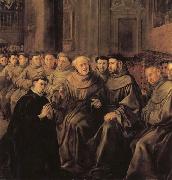 |
Francisco de herrera the elder
|
|
Spanish Baroque Era Painter, ca.1590-1656
Spanish painter. His early works are in the Mannerist style. Under the influence of Francisco Zurbaren, he developed the naturalistic style seen in his four scenes from the life of St. Bonaventure (1627). About 1650 he moved to Madrid. His last documented work, a painting of St. Joseph (1648) influenced by Anthony Van Dyck, features elongated forms and elaborate draperies. He achieved considerable fame in Sevilla, where Diego Velezquez was briefly his pupil. His work marked the transition from Mannerism to the Baroque. His son, Francisco Herrera the Younger |
|
|
|
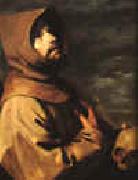 |
Francisco de Zurbaran
|
|
1598-1664
Spanish Francisco de Zurbaran Galleries
Spanish baroque painter, active mainly at Llerena, Madrid, and Seville. He worked mostly for ecclesiastical patrons. His early paintings, including Crucifixion (1627; Art Inst., Chicago), St. Michael (Metropolitan Mus.), and St. Francis (City Art Museum, St. Louis), often suggest the austere simplicity of wooden sculpture. The figures, placed close to the picture surface, are strongly modeled in dramatic light against dark backgrounds, indicating the influence of Caravaggio. They were clearly painted as altarpieces or devotional objects. In the 1630s the realistic style seen in his famous Apotheosis of St. Thomas Aquinas (1631; Seville) yields to a more mystical expression in works such as the Adoration of the Shepherds (1638; Grenoble); in this decade he was influenced by Ribera figural types and rapid brushwork. While in Seville, Zurbur??n was clearly influenced by Velazquez. After c.1640 the simple power of Zurbaran work lessened as Murillo influence on his painting increased (e.g., Virgin and Child with St. John, Fine Arts Gall., San Diego, Calif.). There are works by Zurbar??n in the Hispanic Society of America, New York City; the National Gallery, Washington, D.C.; and the Philadelphia Museum of Art.. |
|
|
|
|
|
 |
Francisco Goya
|
|
1746-1828
Goya is considered the 18th Century's foremost painter and etcher of Spanish culture, known for his realistic scenes of battles, bullfights and human corruption. Goya lived during a time of upheaval in Spain that included war with France, the Inquisition, the rule of Napoleon's brother, Joseph, as the King of Spain and, finally, the reign of the Spanish King Ferdinand VII. Experts proclaim these events -- and Goya's deafness as a result of an illness in 1793 -- as central to understanding Goya's work, which frequently depicts human misery in a satiric and sometimes nightmarish fashion. From the 1770s he was a royal court painter for Charles III and Charles IV, and when Bonaparte took the throne in 1809, Goya swore fealty to the new king. When the crown was restored to Spain's Ferdinand VII (1814), Goya, in spite of his earlier allegiance to the French king, was reinstated as royal painter. After 1824 he lived in self-imposed exile in Bordeaux until his death, reportedly because of political differences with Ferdinand. Over his long career he created hundreds of paintings, etchings, and lithographs, among them Maya Clothed and Maya Nude (1798-1800); Caprichos (1799-82); The Second of May 1808 and The Third of May 1808 (1814); Disasters of War (1810-20); and The Black Paintings (1820-23). |
|
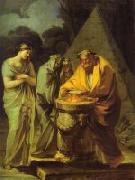 |
Francisco Jose de Goya
|
|
Spanish Rococo Era/Romantic Painter and Printmaker, 1746-1828
Goya is considered the 18th Century's foremost painter and etcher of Spanish culture, known for his realistic scenes of battles, bullfights and human corruption. Goya lived during a time of upheaval in Spain that included war with France, the Inquisition, the rule of Napoleon's brother, Joseph, as the King of Spain and, finally, the reign of the Spanish King Ferdinand VII. Experts proclaim these events -- and Goya's deafness as a result of an illness in 1793 -- as central to understanding Goya's work, which frequently depicts human misery in a satiric and sometimes nightmarish fashion. From the 1770s he was a royal court painter for Charles III and Charles IV, and when Bonaparte took the throne in 1809, Goya swore fealty to the new king. When the crown was restored to Spain's Ferdinand VII (1814), Goya, in spite of his earlier allegiance to the French king, was reinstated as royal painter. After 1824 he lived in self-imposed exile in Bordeaux until his death, reportedly because of political differences with Ferdinand. Over his long career he created hundreds of paintings, etchings, and lithographs, among them Maya Clothed and Maya Nude (1798-1800); Caprichos (1799-82); The Second of May 1808 and The Third of May 1808 (1814); Disasters of War (1810-20); and The Black Paintings (1820-23). |
|
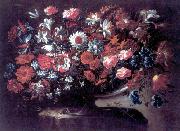 |
Francisco Lopez Caro
|
|
(1578-1662) was a Spanish painter of the Baroque period. Born in Seville, he was a pupil of Juan de las Roelas. We know very little of him, save that he painted with indifferent success in Seville until about 1660, when he went to Madrid where he spent the remainder of his life, and died in 1662. His works were mainly portraits, some of which are in private collections in Madrid, Salamanca, Granada, and Seville. |
|
|
|
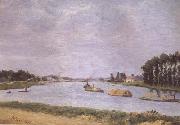 |
Francisco Oller y Cestero
|
|
San Juan,Puerto Rico 1833-Santurce 1917
Puerto Rican painter. He studied from 1851 to 1853 at the Real Academia de Bellas Artes de San Fernando in Madrid under Federico de Madrazo y Kentz and in Paris from 1858 to 1863 under Thomas Couture and Charles Gleyre at the Ecole Imperiale et Speciale de Dessin and at the Academie Suisse. There he met Camille Pissarro, Paul Cezanne and Armand Guillaumin, who together with Couture and the work of Courbet influenced his work towards Realism and Impressionism. |
|
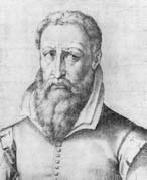 |
Francisco Pacheco
|
|
Spanish painter, teacher, and schola
1564-1644, Spanish painter and writer. He is not considered to be a great painter, but he is remembered for his theoretical work Arte de la pintura. The book is the most important contribution to Spanish artistic theory in the 17th century.
|
|
|

